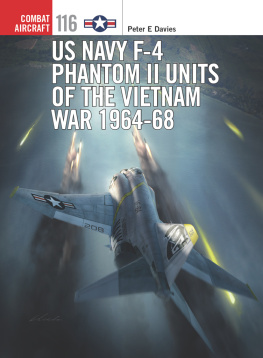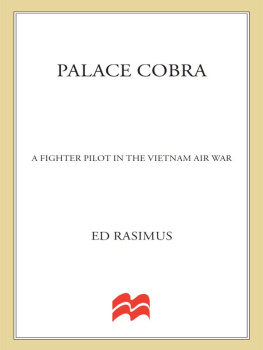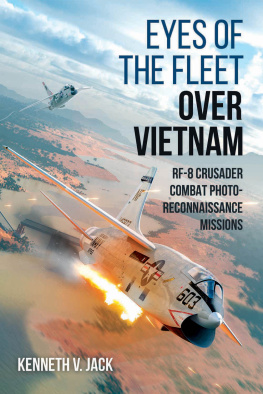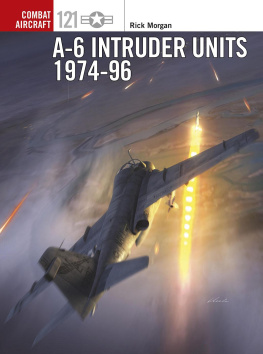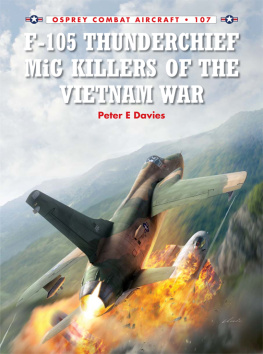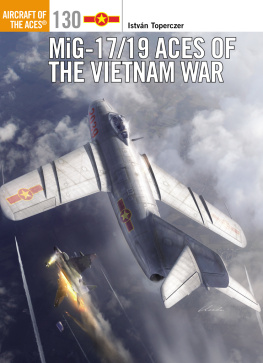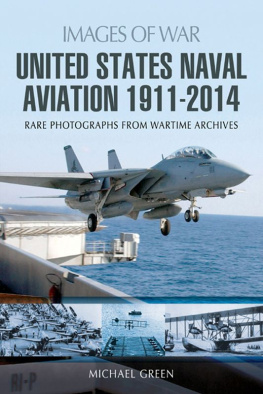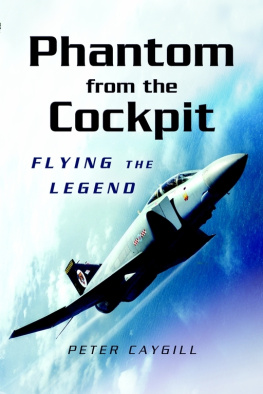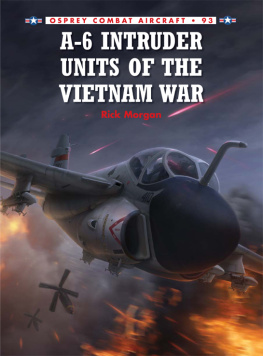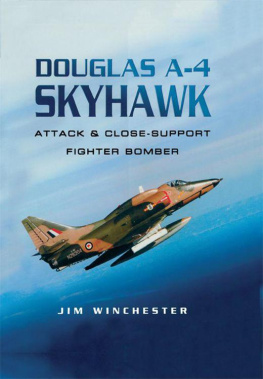
This book is dedicated to the memory of Capt John Nash, US Navy
Author
Peter E Davies has published 26 books concentrating on modern combat aircraft and the Vietnam War. He has written 16 previous Osprey titles and co-authored two others. Four of these have concentrated on the US Navys use of the F-4 Phantom II, and another of his books, running to 250 pages on this topic for American publisher Schiffer, is still selling 16 years after publication. All his books on this subject have contained extensive input from interviews with more than 100 former US Navy Phantom II aircrew, maintainers and mission planners.
Illustrator
Jim Laurier is a native of New England, growing up in New Hampshire and Massachusetts. He has been drawing since he could hold a pencil and throughout his life he has worked in many mediums creating artwork on a variety of subjects. He has worked on the Osprey Aviation list since 2000, and in that time he has produced some of the finest artwork seen in these volumes. He has specialised in aircraft of the Vietnam War period.
Acknowledgements
The author is grateful to the following individuals for their assistance Capt George K Baldry US Navy (ret), Lt David Batson US Navy (ret), Capt Roy Cash US Navy (ret), Cdr Charles DAmbrosia US Navy (ret), Capt Orville G Elliott US Navy (ret), Cdr Grover G Erickson US Navy (ret), Cdr Guy H Freeborn US Navy (ret), Cdr William E Greer III US Navy (ret), Capt William B Haff US Navy (ret), John J Harty (McDonnell Douglas), Capt Jerry B Houston US Navy (ret), Lt W Fritz Klumpp US Navy (ret), Capt William D Knutson US Navy (ret), Capt Eugene P Lund US Navy (ret), Mary Jane at VetFriends, Lt Cdr William J Mayhew US Navy (ret), Cdr Stephen A Rudloff US Navy (ret), Capt Frederick G Staudenmayer US Navy (ret) and RADM John R Wilson Jr US Navy (ret).
Front Cover
On the night of 26 October 1965 F-4B Phantom II BuNo 151505, call-sign Victory 208, from VF-84 Jolly Rogers,embarked in USS Independence (CVA-62), was involved in a three-aircraft attack on targets of opportunity located on Bach Long Vi Island, 70 miles off the North Vietnamese coast. Lt Grover Erickson (pilot) and Lt(jg) John Perry (RIO) arrived on target over a torpedo boat anchorage at 0100 hrs and dropped six Mk 24A parachute flares from a height of 6000 ft in order to illuminate the target. They followed up with a firing pass in which four LAU-3A rocket pods of 2.75-in unguided rockets were launched from 2500 ft in a 450-kt 20-degree dive.
As Lt Erickson turned hard right to clear the target he felt two AAA hits on his aircraft, one in the tail area and another in the wing root. He quickly lost rudder control, the undercarriage extended and then retracted and fire warning lights appeared. As smoke began to enter the cockpit and a complete electrical failure occurred the two men ejected and were soon recovered by a UH-2A rescue helicopter (Cover artwork by Gareth Hector)

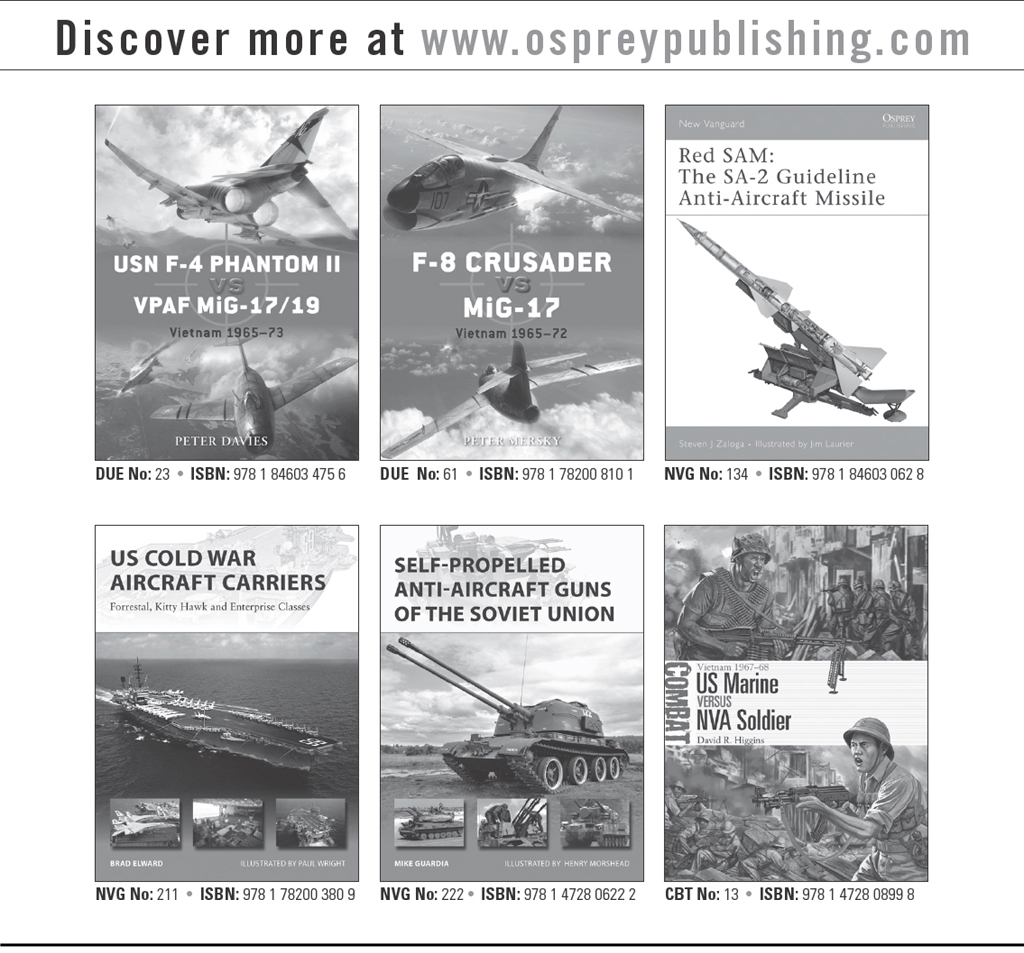
First published in Great Britain in 2016 by Osprey Publishing
PO Box 883, Oxford, OX1 9PL, UK
1385 Broadway, 5th Floor, New York, NY 10018, USA
E-mail:
Osprey Publishing, part of Bloomsbury Publishing Plc
This electronic edition published in 2016 by Bloomsbury Publishing Plc
Bloomsbury is a registered trademark of Bloomsbury Publishing Plc
2016 Osprey Publishing Ltd.
All rights reserved
You may not copy, distribute, transmit, reproduce or otherwise make available this publication (or any part of it) in any form, or by any means (including without limitation electronic, digital, optical, mechanical, photocopying, printing, recording or otherwise), without the prior written permission of the publisher. Any person who does any unauthorised act in relation to this publication may be liable to criminal prosecution and civil claims for damages.
A CIP catalogue record for this book is available from the British Library
ISBN: 978-1-4728-1451-7 (PB)
ISBN: 978-1-4728-1452-4 (eBook)
ISBN: 978-1-4728-1453-1 (ePDF)
Edited by Tony Holmes
Cover Artwork by Gareth Hector
Aircraft Profiles by Jim Laurier
Osprey Publishing supports the Woodland Trust, the UKs leading woodland conservation charity. Between 2014 and 2018 our donations will be spent on their Centenary Woods project in the UK.
www.ospreypublishing.com
To find out more about our authors and books visit www.ospreypublishing.com. Here you will find our full range of publications, as well as exclusive online content, details of forthcoming events and the option to sign up for our newsletters. You can also sign up for Osprey membership, which entitles you to a discount on purchases made through the Osprey site and access to our extensive online image archive.
CHAPTER ONE
THUNDER CLOUDS
As hostilities in Southeast Asia intensified in mid-1964, McDonnells F-4B Phantom II was already well established as the US Navys all-weather, missile-armed interceptor. Within the Pacific Fleet, five squadrons VF-21, VF-92, VF-96, VF-114 and VF-143 were in business with F-4Bs by 1963, joined by VF-142, VF-151, VF-154 and VF-161 by December 1965. Nine Atlantic Fleet squadrons were also operating Phantom IIs by that time, and several of them would eventually be involved in the Vietnam War too. Most of these units had converted from McDonnell F3H Demon or Douglas F4D Skyray fighters, but from 1964 several F-8 Crusader squadrons, including VF-32, VF-33, VF-84 and VF-154, began to transition to the two-seat Phantom II. However, in July 1964 F-8s still outnumbered F-4s in the Pacific Fleet, although the balance was steadily shifting towards the more versatile Phantom II with its greater attack capability. Excelling in the day fighter role, Crusader squadrons had achieved 18 confirmed MiG kills by the end of Operation Rolling Thunder, with three losses to MiGs, compared with ten official kills for the F-4 units and four losses to MiGs.

McDonnells predecessor to the F-4 Phantom II was the F3H-2 Demon, which equipped VF-14 Tophatters from January 1956. The squadron had previously flown the F3D-2 Skyknight from 1954, gaining some pioneering experience in all-weather, radar-equipped interception. VF-14s original 1955 conversion date to the Demon was long delayed by development problems with the F3H. The Tophatters eventually deployed, onboard Forrestal, for the first time in January 1957 and made their last Demon cruise in April 1963 before upgrading to the F-4B Phantom II (US Navy)
The Phantom II component in a carrier air wing for the larger carriers (Midway class and above) usually comprised two squadrons, each with 12 aircraft, although space restrictions often meant that ten would be embarked and two or more retained ashore undergoing repair or kept as spares. For their 1965 cruises, USS Coral Sea (CVA-43) and USS Midway (CVA-41) paired single F-4B units with F-8D squadrons. Although Crusader gun-fighter pilots remained fiercely loyal to their steeds, many were depressed to see their definitive F-8Es loaded with bomb pylons and equipped with radar that greatly increased the pilots work-load. In an F-4 there was a Radar Intercept Officer (RIO) to take care of all that. Many pilots also believed that the Phantom II was a better fighter at the medium to low altitudes where most Vietnam War aerial engagements occurred.

